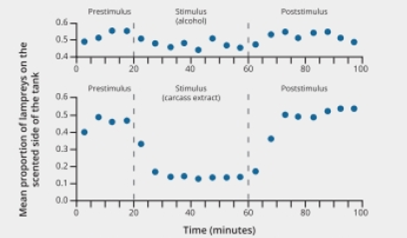
Concept explainers
Deathly Lamprey Repellent Predation by sea lampreys on native fishes in the Great Lakes is an ongoing problem. To help solve it, Michael Wagner and his team test methods of repelling lampreys. They carried out an experiment to investigate reports that sea lampreys detect the scent of lamprey carcasses and tend to avoid them. The researchers made alcohol-based lamprey carcass extracts, then observed what happened when lampreys were put in tanks and exposed to either this extract or to alcohol alone. FIGURE 25.6 shows their results.

FIGURE 25.6 Effectiveness of carcass extracts as a lamprey repellent.
Mean proportion of lampreys on the scented side of the test tank during B trials with 10 lampreys. Lampreys were placed in the tank for 20 minutes before exposure to alcohol or carcass extract and remained there for 40 minutes after exposure. The upper graph shows results with alcohol as the stimulus; the lower shows the results with carcass extracts. Bars indicate standard error.
Why was it necessary to test the response of lampreys to the scent of alcohol alone?
To explain: The reason why it is necessary to test the response of lampreys to the scent of the alcohol alone
Concept introduction: Sea lampreys are chordates that are classified as jawless fishes and are major parasitic carnivorous chordates. The sea lampreys are pests in the Great lakes of the USA as they cause loss of several commercial fishes.
Explanation of Solution
In order to reduce the menace of the lampreys, Scientist M and his team designed an experiment to investigate and report that sea lampreys detect the scent of other lamprey carcasses and have the nature to avoid them. The team used alcohol-based extracts of lamprey carcasses. They then observed the results when lampreys were put in two tanks: one with the alcohol-based extract and another with alcohol alone.
The alcohol serves as a control. The lampreys should not have any reaction towards alcohol as they are the additional substance present along with the tissue extract of lamprey carcass. Therefore, it is necessary to confirm that lampreys are not attracted to the scent alcohol.
The lampreys exposed to alcohol alone in the tank will help us to confirm if the lampreys are attracted to the carcass alone or both alcohol and carcass combined.
Want to see more full solutions like this?
Chapter 25 Solutions
Biology: The Unity and Diversity of Life (MindTap Course List)
Additional Science Textbook Solutions
SEELEY'S ANATOMY+PHYSIOLOGY
General, Organic, and Biological Chemistry - 4th edition
Introductory Chemistry (6th Edition)
Chemistry: Atoms First
Genetics: From Genes to Genomes
- 22. Which of the following mutant proteins is expected to have a dominant negative effect when over- expressed in normal cells? a. mutant PI3-kinase that lacks the SH2 domain but retains the kinase function b. mutant Grb2 protein that cannot bind to RTK c. mutant RTK that lacks the extracellular domain d. mutant PDK that has the PH domain but lost the kinase function e. all of the abovearrow_forwardWhat is the label ?arrow_forwardCan you described the image? Can you explain the question as well their answer and how to get to an answer to an problem like this?arrow_forward
- Describe the principle of homeostasis.arrow_forwardExplain how the hormones of the glands listed below travel around the body to target organs and tissues : Pituitary gland Hypothalamus Thyroid Parathyroid Adrenal Pineal Pancreas(islets of langerhans) Gonads (testes and ovaries) Placentaarrow_forwardWhat are the functions of the hormones produced in the glands listed below: Pituitary gland Hypothalamus Thyroid Parathyroid Adrenal Pineal Pancreas(islets of langerhans) Gonads (testes and ovaries) Placentaarrow_forward
 Biology: The Unity and Diversity of Life (MindTap...BiologyISBN:9781305073951Author:Cecie Starr, Ralph Taggart, Christine Evers, Lisa StarrPublisher:Cengage Learning
Biology: The Unity and Diversity of Life (MindTap...BiologyISBN:9781305073951Author:Cecie Starr, Ralph Taggart, Christine Evers, Lisa StarrPublisher:Cengage Learning Biology Today and Tomorrow without Physiology (Mi...BiologyISBN:9781305117396Author:Cecie Starr, Christine Evers, Lisa StarrPublisher:Cengage Learning
Biology Today and Tomorrow without Physiology (Mi...BiologyISBN:9781305117396Author:Cecie Starr, Christine Evers, Lisa StarrPublisher:Cengage Learning





